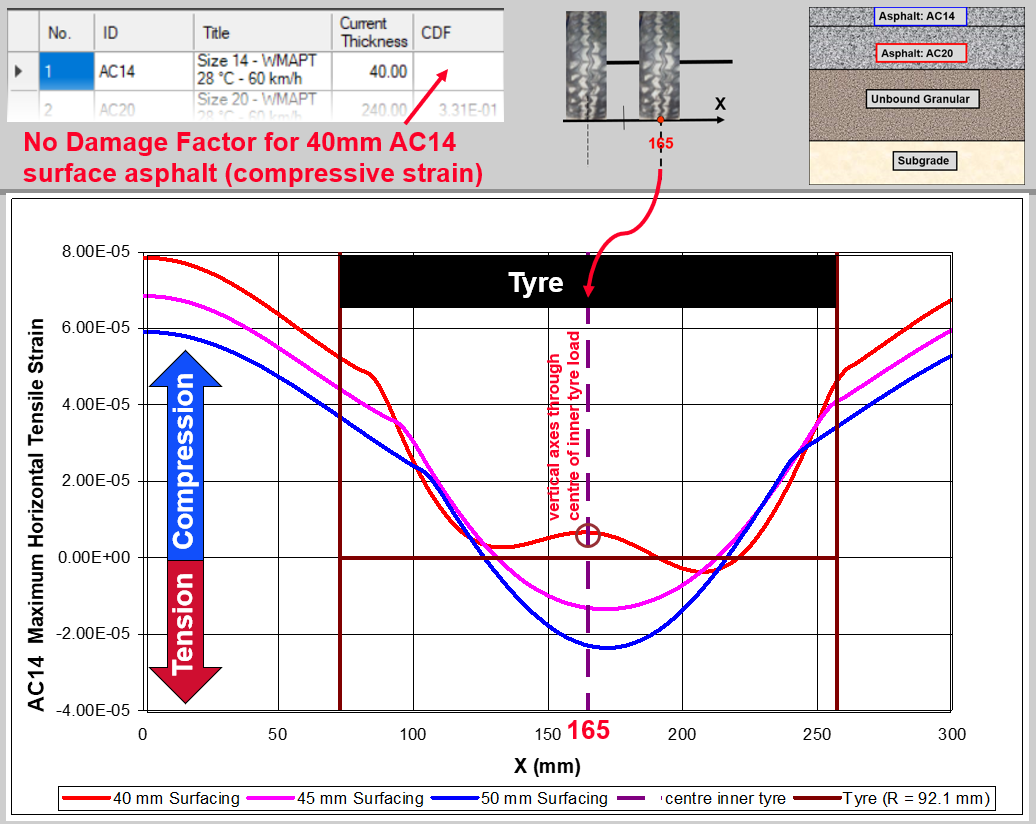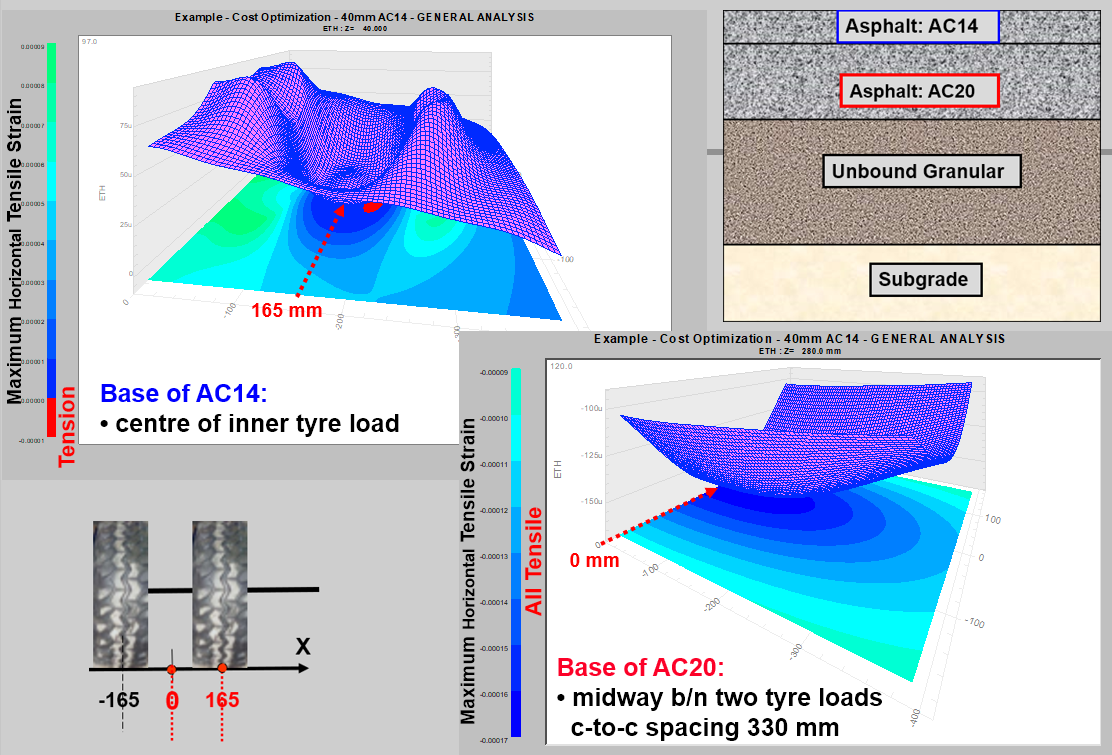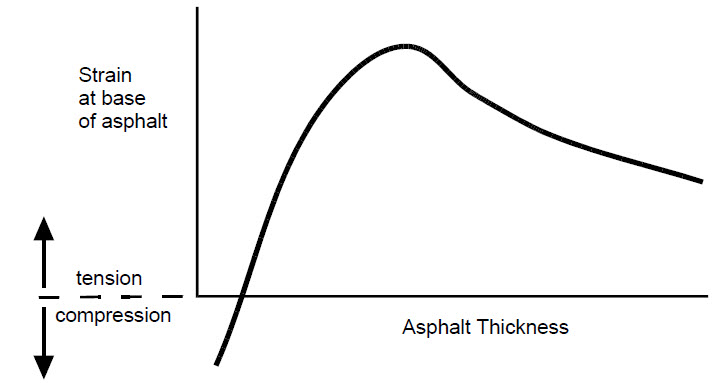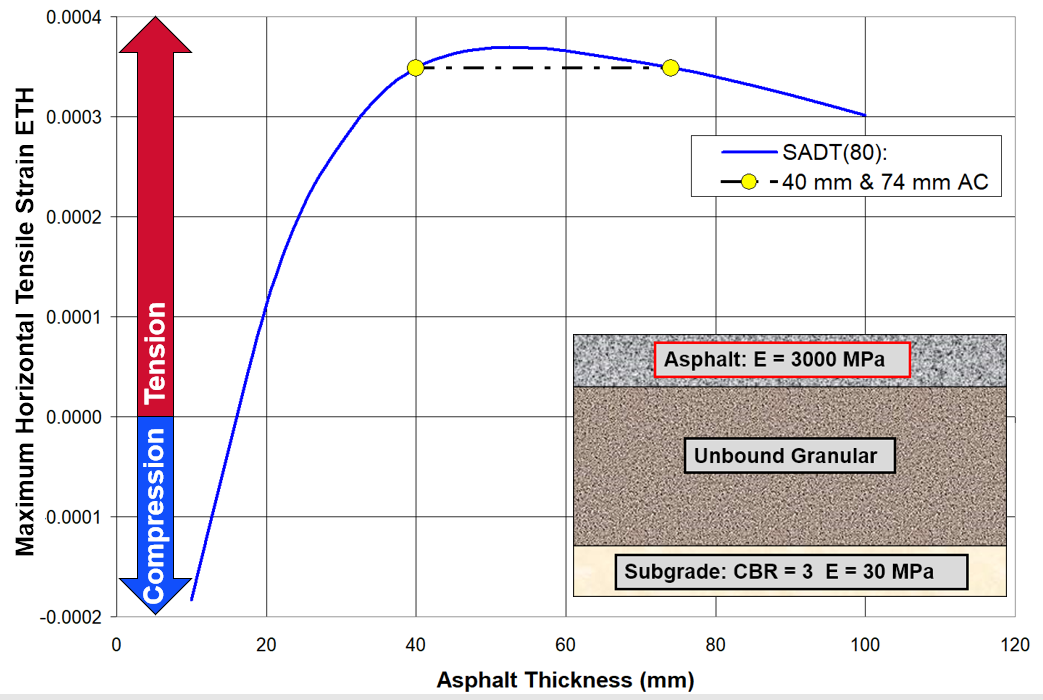Important CIRCLY 7.0 Update – February 2022 – Further Information
The following discussion regarding thin bituminous surface layers involves two cases:
– an asphalt wearing course over a base asphalt course, and
– a single wearing asphalt layer over a granular base
Thin asphalt surface layers do not typically fatigue as they are usually in compression due to the proximity of the wheel loading.
The following figure illustrates the transition from compression to tension for horizontal strains underneath the surface AC14 layer as the asphalt thickens from 40 mm to 50 mm. The critical horizontal strain location under Standard Axle loading is at the centre of the inner tyre for these cases. Note that the surface AC14 is located above an AC20 asphalt layer.

The following 3D contour plot shows the horizontal strains at the base of the AC14 and AC20 respectively. Note the horizontal strains are all tensile for the base of the AC20.

Following is a discussion from Section 8.2 Mechanistic-empirical Procedure and Appendix K in the Austroads Guide to Pavement Technology Part 2: Pavement Structural Design that describes thin (<50 mm) asphalt pavement design implications.
Section 8.2 Mechanistic-empirical Procedure, states the following (our italics):
“For some projects, the mechanistic-empirical modelling may indicate that both a thin (< 50 mm) and thick asphalt surfaced pavement can be adopted.
Caution is advised in adopting the thin asphalt surfaced pavement option because the dominant damage types are not necessarily those addressed by the design model and as a consequence mechanistic-empirical modelling of asphalt layers less than 40 mm thick is less certain than for thicker asphalt layers (Section 8.2.7 – see later).
Appendix K ‘Effect of Asphalt Thickness on Fatigue Life of Asphalt-Surfaced Pavements’ discusses why more than one asphalt thickness is theoretically possible.
Appendix K includes Figure K 1: General relationship between asphalt thickness and horizontal strain at the base of an asphalt layer.

The key point is that there are generally two asphalt thicknesses that give the same magnitude of strain located to the left and the right of the maximum point.
The following figures based on CIRCLY analysis results illustrate this point.

The same strain occurs at the critical strain point (centre of the inner tyre load) for this pavement structure with a surface asphalt layer thickness of 40 mm and also 74 mm.
The horizontal strain moves from compression to tension as the layer thickens and stiffens and begins impacting the pavement behaviour. The horizontal strain typically peaks for a surface thickness of between 40 mm and 80 mm with highway traffic loading. Beyond this range pavement flexure decreases and the asphalt horizontal strain also reduces.
Following is further discussion from Austroads Guide to Pavement Technology Part 2: Pavement Structural Design regarding thin bituminous surfacings.
Section 8.2.7 ‘Design of Granular Pavements with Thin Bituminous Surfacings’ which describes the implication of using thin asphalt surfacings:
Designers are cautioned, however, that the mechanistic-empirical design model has not been validated for granular pavements having asphalt surface layers less than 40 mm thick and that there is considerable uncertainty associated with the use of the model for these pavements.
In particular, while the design model may suggest that pavements with thin asphalt surfacings can perform comparably to thick asphalt pavements at high traffic loadings, it does not adequately account for the impact of traffic loads on these thin surfacings.
The section details various inadequacies of mechanistic-empirical design procedures when used to design granular pavements with thin bituminous surfacings.
Section 2.2.4 Granular Pavements with Thin Asphalt Surfacings
Some agencies restrict the use of single layer asphalt surfacings on new pavements because of the performance risks associated with them. They are not commonly used for urban freeway applications due to the risk of premature distress
Section 3.13 Acceptable Risk
A typical example of this is the performance of thin (< 50 mm thick) asphalt-surfaced granular pavements compared with thick (> 100 mm) asphalt pavements for high traffic loadings.
The thin asphalt is more susceptible to adverse temperature conditions at the time of placement (e.g. insufficient density), the fatigue performance of the thin asphalt is highly dependent on the stiffness of the underlying granular materials and the fatigue life of the surfacing is highly dependent on its thickness, even within normal construction tolerances.
Therefore, although the thin asphalt-surfaced granular pavement may achieve the design objectives, there are numerous factors that may affect its field performance.
